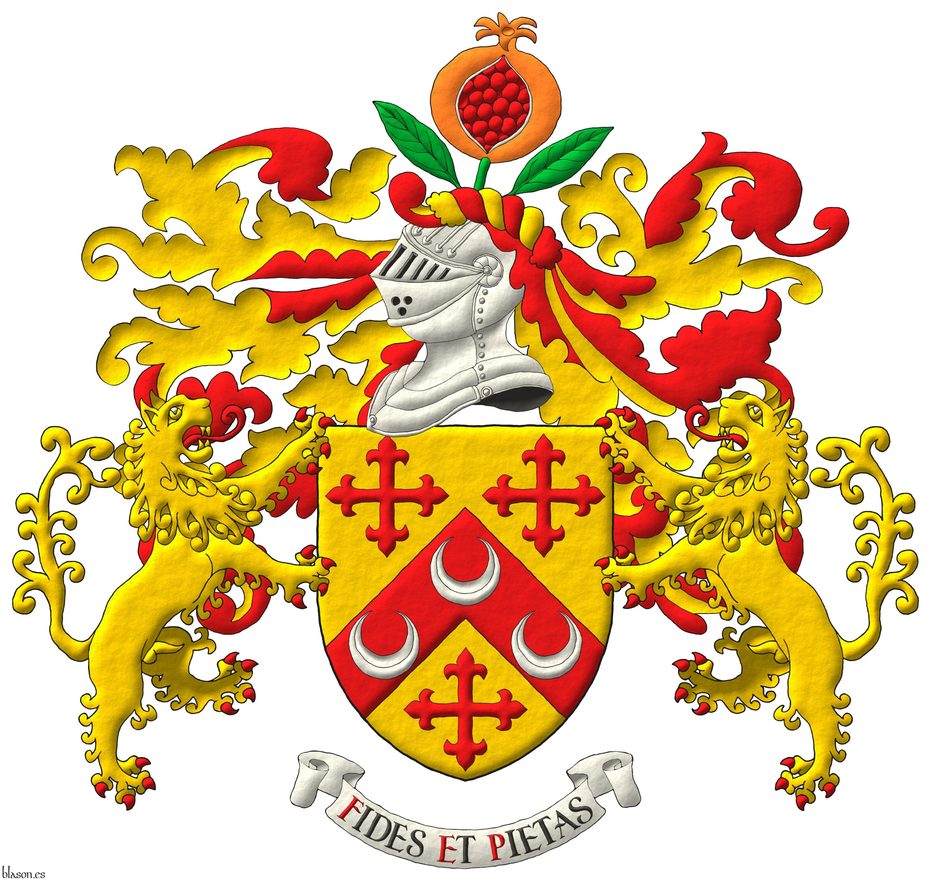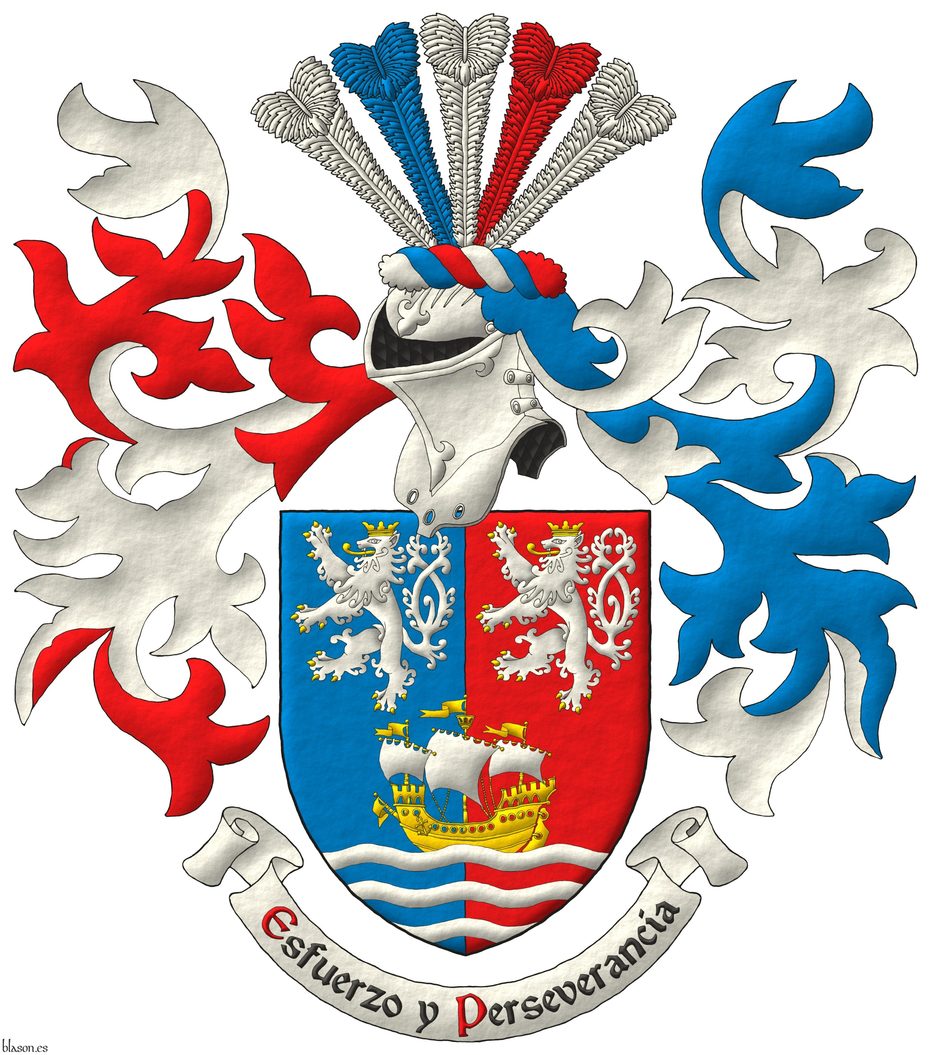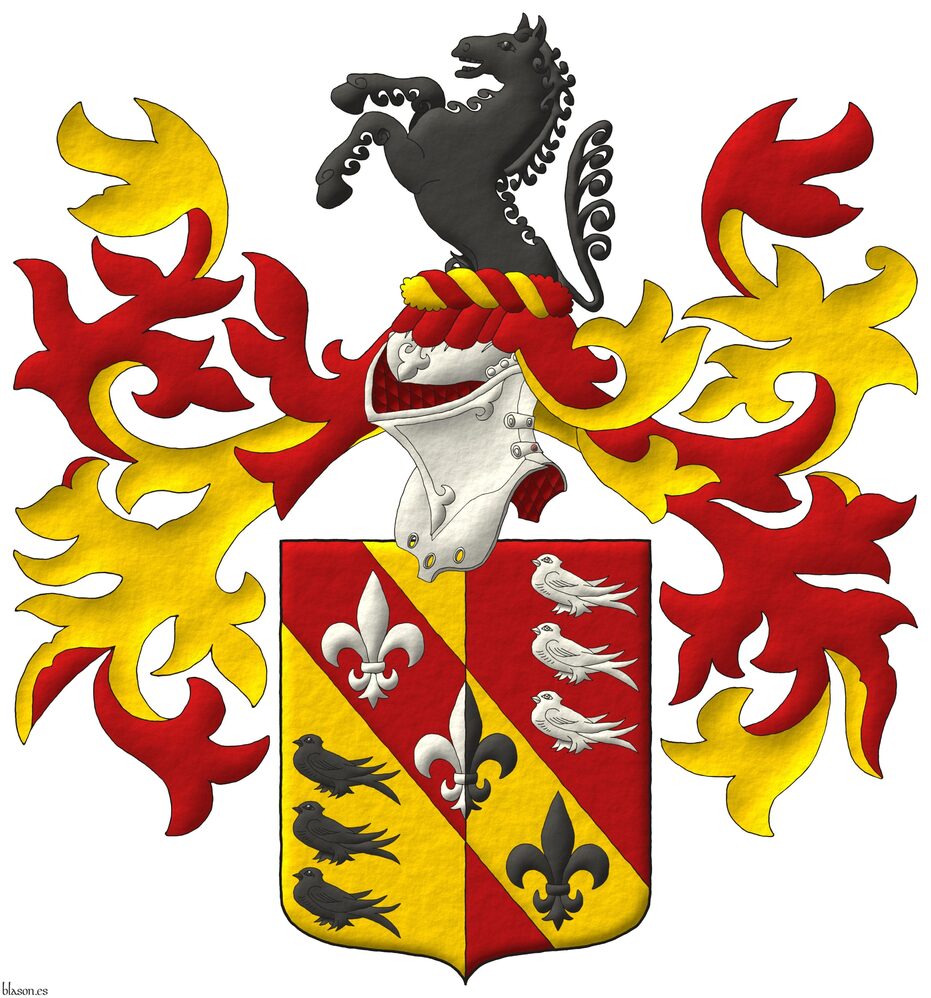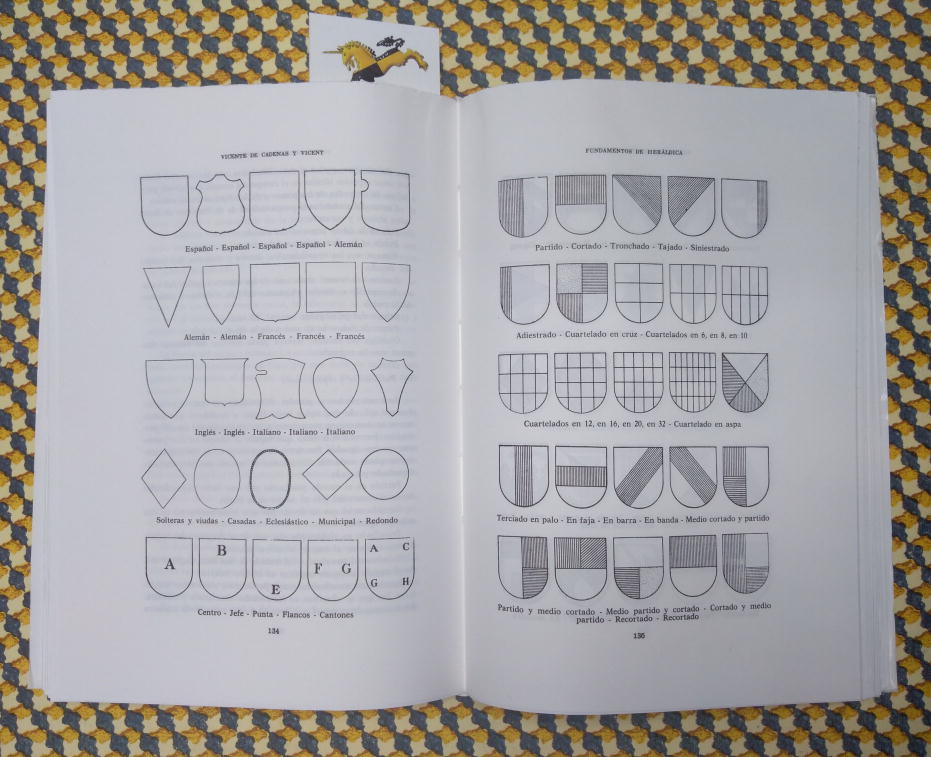
A coat of arms for your personal brand
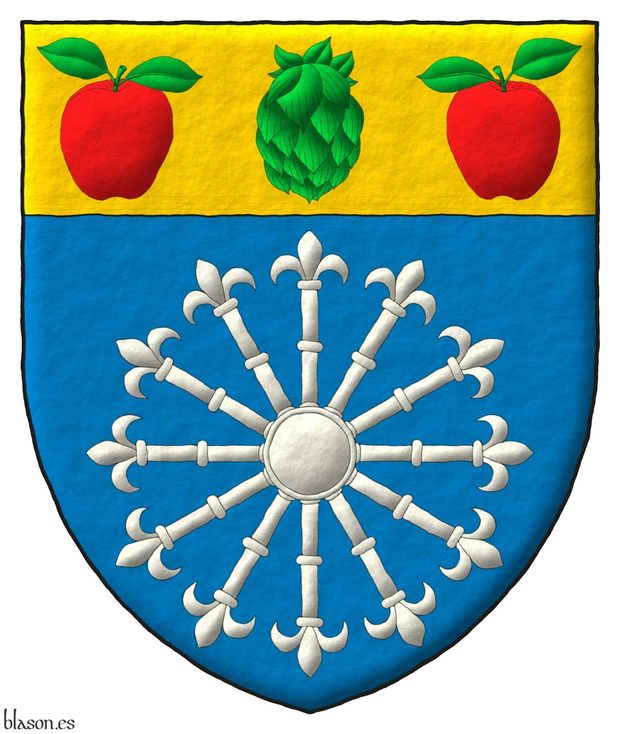
For some years the concept of «personal brand» has been expanded, a concept that, moreover, is powered by the internet.
The idea of personal branding is based on creating, developing, conveying, and protecting the image and impression you give of yourself to others, both in direct and indirect interaction—whether in person or, for instance, through social media. Your personal brand supports you as a professional when presenting your abilities, as a businessperson in your social relationships, and even in your job search.
This concept of personal branding tells you that you not only need to improve and strengthen yourself as a person or as a professional, but also that others should perceive and remember it. In this way, you can stand out and achieve greater success in your social, business, and professional relationships.
Your personal brand is built step by step; in it, the details matter, and you should also aim for the impression you make to be long-lasting.
For this reason, a personal coat of arms can be an ideal complement to your personal brand. When used wisely, it is, unlike other elements, enduring over time and can enhance and elevate your personal relationships.
The natural way to integrate your coat of arms into your personal brand is not to expect the coat of arms to provide it automatically, but rather to develop it through a cycle of positive feedback, in which your good conduct and professionalism dignify your arms, and your arms, in turn, reflect and communicate that worth continuously.


Freedom and legitimacy to adopt arms
In Spain we are all legitimated to adopt and have our own coat of arms, it is a privilege that we can give ourselves in a pure exercise of freedom, is a right that has been passed down to us throughout our history, and it is as beautiful and simple as it seems.
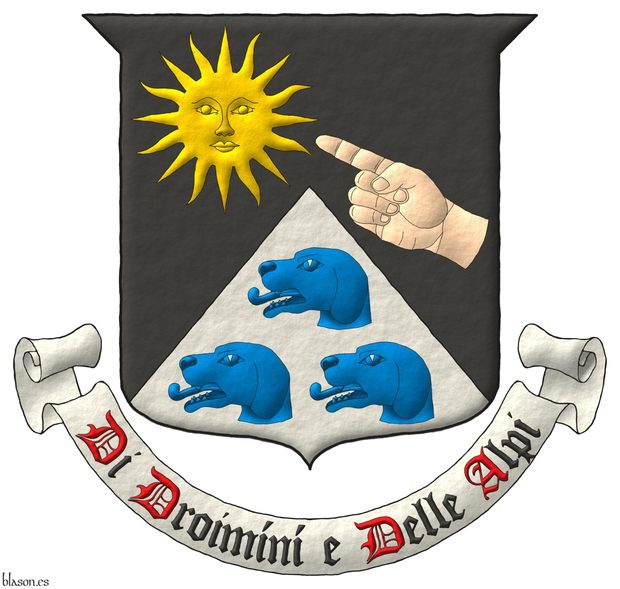
Fernando Garcia-Mercadal and García-Loygorri is one of the experts who best described this idea when he writes: «It is the adoption itself... the original way of acquiring a personal blazon that consists of the intellectual of a new coat of arms by whom it intends to make it his own, having the capacity and intention to assume it and subject it to heraldic laws and customs...» and on the basis of it makes us notice that «it can be maintained that every person... has the right, nowadays, to take on new arms, with the exception of blazons owned by others or the acquisition of one which is contrary to law». According to the same author, the proper adoption of a coat of arms has 3 outstanding features [García-Mercadal y García-Loygorri, F.; 2012; page 281]:
- «Is an act... that can have legal effects,... which implies an intellectual creation,... the mental invention of a certain form and contents that in Western culture are known as coat of arms or blazon»,
- «Has an identifiable purpose, inasmuch as its object is to be represented by means of the same and, as the case may be, transmit it to its heirs» and
- «is not an act of free will, since the suitor must submit his armories to design rules».


Creation of your coat of arms
The creation of your coat of arms admits many possibilities, being the basic one the creation of the blazon, that is, its heraldic description. From there,
- you can choose all the ornament of your shield, for example, whether or not it has a crest, whether or not it has a mantling, that your arms have supporters, or tenants, moreover
- you can choose your own complements, for example, wish to have a flag according to your coat of arms, create your own badge, your personal seal, your ex libris, etc.
My heraldic art covers all of the above, from initial conception to final design, both in digital support and through a printed heraldic document which contains all the pieces created for you in a personalized way and even other tangible complements, such as, for framing or sealing.


You can have your own coat of arms
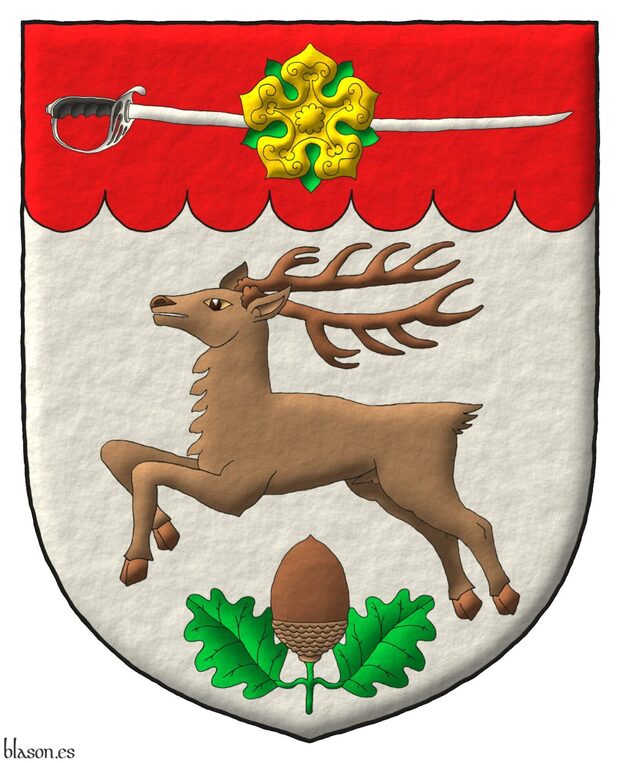
Everyone is able to get their own coat of arms, this is so in Spain and many other countries of the world and the way to get it is very simple.
The most direct way to possess a coat of arms is to create it and adopt it as your own.
However there are other ways of acquiring it, for example, inheritance, concession, acquisitive prescription, some already impossible such as capture in combat and other illusories, such as to believe that we had bought one in series equal to that people with a similar surname, when our coat of arms, as it is our own signature, is something absolutely personal.
In order to create your own coat of arms you can count on my help. Your coat of arms has to represent and be a reflection of your ideals, goals, motivations or what you want to express, but also have to follow the heraldic rules of the coat of arms and it must also follow the heraldic rules of blazon and be created with artistry and skill, and that is what I take care of.
While creating the coat of arms I follow a heraldic creation methodology that starts from the customs initial wishes and ideas about their future coat and follows a process of advancement and refining until its definitive creation.
A coat of arms is described by its blazon and admits different forms of artistic expression. Thus, a coat of arms and its blazon are something much richer and freer than the logo concept. All logos are registred and therefore restricted to severe standards in terms of colors, shapes and dimensions, which leaves no room for creativity.
Nevertheless, when a blazon is said to be «a Unicorn Argent, salient», each artist can create a different unicorn in a more or less stylized jumping attitude and where their silver color can be chosen from a wide range of light grays and even many types of white.
Therefore, your new personal shield created with my help can later be interpreted by other artists that provide other different and enriching visions, and can also be portrayed on different media such as paper, wood, metal, etc. In turn, if you already have armories of your own, I would be delighted to carry out my own interpretation of them.


![Ver [Cadenas y Vicent, V. de; 1975] en referencias bibliográficas. Libro abierto, hojas de plata, filo de oro, guardas de gules, tapas de sable.](../css/Libro.Bibliografia.png)
Cadenas y Vicent, V. de; 1975
Vicente de Cadenas y Vicent, Dean King of Arms, «Fundamentos de Heráldica (Ciencia del Blasón)», Instituto Salazar Castro (C. S. I. C. Higher Center for Scientific Research), edited by Ediciones Hidalguía, 212 pages, Madrid, 1975.
There is a 2nd edition from 1994, consisting of 224 pages and ISBN 84-87204-64-3, which is the edition I am able to consult, and which is the edition shown in the previous photograph. In this 2nd edition, the author explains that, when faced with the alternatives of expanding the work with new knowledge or leaving it as it was originally conceived, he chose the latter option, limiting himself to expanding and updating only the bibliography, as he was at that time engaged in the preparation of a new book.
Bibliographical reference of century XX.
Classification: De bibliotheca and In black and white.
Author: Cadenas y Vicent, Vicente de.
Bibliographic reference mentioned in the following articles:
- ANPC, shield with crest and motto
- Fernando Marán Bié, The Armorial Register
- Governance heraldry
- Holy Trinity
- Military heraldry
- Personal Heraldry
- Pile issuant from the base in the Dictionary of the Spanish Language
- Religious heraldry
- Socioeconomic heraldry
- Supporter
External link:
Internal resources: CadenasVicentV1975.FundamentosHeraldica.txt and Physical book on paper.


![Ver [García-Mercadal y García-Loygorri, F.; 2012] en referencias bibliográficas. Libro abierto, hojas de plata, filo de oro, guardas de gules, tapas de sable.](../css/Libro.Bibliografia.png)
García-Mercadal y García-Loygorri, F.; 2012
Fernando García-Mercadal y García-Loygorri, «La Regulación Jurídica de las Armerías: Apuntes de Derecho Heráldico Español», [Emblemata; 2012; pages 259-297], Volume 18th, Aragonesa de Emblemática Magazine, ERAE, Fernando El Católico Institution, ISSN 1137-1056, Zaragoza, 2012.
Bibliographical reference of century XXI.
Classification: Article.
Author: García-Mercadal y García-Loygorri, Fernando.
The following article cites this bibliographic reference:
External link:
Internal resources: GarciaMercadalF2012.Regulacion.pdf.


Artistic style
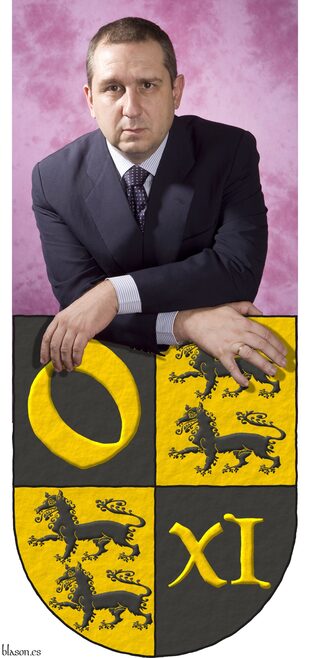
I would describe my heraldic artistry with three terms: clarity, symbolism, and methodology.
- It is clear because my work aims to create pieces that transmit energy and vital force to the owner and their relatives. I believe that a coat of arms should be a source of light and joy and an expression of freedom. That's why, in my heraldic creative process, I prefer drawing inspiration from the early stages of heraldic history to bring that freshness into the present.
- It is symbolic because coats of arms must represent their bearer, his/her ideals, goals, motivations, history, and anything he/she might want to display. Thus, the creation of a coat of arms should encompass all the meanings and symbols brought forth by the future owner, in accordance with heraldic rules and artistic contributions.
- It is methodical because heraldic art is founded on a science, the so-called «science of heraldry». This systematic knowledge has its principles, its composition rules, and its own formal language, all of which are the true foundations of my artistic methodology. The method should not be seen as a deterrent to creativity, but rather as a solid support and a guarantee of professional work.
This brief description of my artistic style is elaborated on in the following series of articles, where I provide a broader insight into my methodology, my artistic techniques, and my journey both artistically and personally.


![Ver [Emblemata; 1997] en referencias bibliográficas. Libro abierto, hojas de plata, filo de oro, guardas de gules, tapas de sable.](../css/Libro.Bibliografia.png)
Emblemata; 1997
Baron of Valdeolivos Emblematic Chair, of the Fernando el Catolico Institution, of the Centre of Scientific Research (C. S. I. C.) and of the Government of Zaragoza, «Emblemata», Volume 3rd, Emblemata Aragonese Magazine about Emblems (E. R. A. E.), 480 pages, 116 pictures, 2 maps, ISSN 1137-1056, Legal deposit Z.3.937 1996, printed by the Cooperativa de Artes Gráficas Librería General, Zaragoza, 1997.
Bibliographical reference of century XX.
Classification: Magazine and Castilian language.
Author: Cátedra de Emblemática Barón de Valdeolivos.
External resource:

Continue with: Legal notice and data privacy.
-
Language
-
Categories of heraldry
-
Divisions of the field
- Without divisions
- Party per pale
- Party per fess
- Party per bend
- Party per bend sinister
- Tierce
- Tierce sinister
- Tierced per pale
- Tierced per fess
- Tierced per bend
- Tierced pallwise inverted
- Quarterly
- Quarterly per saltire
- Gyronny
- Party per fess, the chief per pale
- Party per pale, the sinister per fess
- Party per fess, the base per pale
- Party per pale, the dexter per fess
- Chapé
- Chaussé
- Embrassé
- Contre-embrassé
- Party per chevron
- Enté
- Enté en point
- Flanched
-
Metals
-
Colours
-
Furs
-
Other tinctures
-
Ordinaries and sub-ordinaries
-
Diminutives of the ordinaries
-
Geometric charges
-
Composite ordinaries
-
Inanimate charges from Nature
Atom, Crescent, Diamond, Emerald, Estoile, Increscent, Lightning flash, Moon, Mount, Mullet, Mullet of four points, Orbital, Plough of Ursa Major, Rainbow, Ray of the sun, River, Sea, Snowflake, Sun, Sun in splendour, Sun of May, Trimount, Water and Wave.
-
Vegetal charges from Nature
Acorn, Apple, Apple tree, Ash, Bluebonnet, Camellia, Chrysanthemum, Cinquefoil, Cornflower, Dogwood flower, Double rose, Elm, Fleur de lis, Flower, Gourd, Holm oak, Hop cone, Kapok tree, Laurel, Lily, Linden, Lotus flower, Madonna lily, Mexican cedar tree, Oak, Olive tree, Palm tree, Plantain plant, Pomegranate, Poplar leaf, Rose, Shamrock, Sunflower, Thistle, Tree, Tulip, Vine and Wheat.
-
Animal charges from Nature
Badger, Bald eagle, Barbel, Barn owl, Bear, Beaver, Beetle, Bighorn sheep, Blackbird, Boar, Brach hound, Bull, Doe, Dog, Dolphin, Dove, Eagle, Elephant, Falcon, Female figure, Fish, Flame, Fly, Fox, Frog, Goat, Goldfinch, Goose, Heron, Horse, Hummingbird, Jaguar, Lark, Leopard, Lion, Lion passant, Lion rampant guardant, Lioness, Lynx, Male figure, Martlet, Merino ram, Owl, Panther, Parrot, Peacock, Pelican, Pelican in her piety, Puffin, Quetzal, Raven, Roe deer, Rooster, Savage, Seagull, Serpent, She-wolf, Stag, Starling, Talbot, Tyger, Vulture, Warren hound and Wolf.
-
Parts of natural charges
Arm, Beak, Branch, Caboshed, Chest, Claw, Covert, Dorsal fin, Eagle claw, Ermine spot, Escallop, Feather, Foot (palmiped), Foreleg, Forepaw, Hand, Head, Heart, Hoof, Leaf, Neck, Ostrich feather, Palm frond, Paw, Roe deers' attires, Shoulder, Sprig, Stags' attires, Stem, Swallow-tail, Tail, Tail addorsed, Tail fin, Talon, Tooth, Trunk, Trunk (elephant), Two hands clasped, Two wings in vol, Udder, Wheat spike, Wing and Wrist.
-
Artificial charges
Ace of spades, Anchor, Anvil, Arch, Arm vambraced, Armillary sphere, Arrow, Axe, Bell, Bell tower, Beret, Bonfire, Book, Bookmark, Bow, Branding iron, Bridge, Broken, Buckle, Cannon, Cannon dismounted, Cannon port, Canopy roof, Carbuncle, Castle, Celtic Trinity knot, Chain, Chess rooks, Church, Clarion, Clay pot, Closed book, Club, Column, Comb, Compass rose, Conductor's baton, Cord, Covered cup, Crozier, Crucible, Cuffed, Cup, Cyclamor, Dagger, Double vajra, Drum, Ecclesiastical cap, Fanon, Federschwert, Fleam, Four crescents joined millsailwise, Galician granary, Garb, Gauntlet, Geometric solid, Grenade, Halberd, Hammer, Harp, Host, Hourglass, Key, Key ward, Knight, Knot, Lantern, Letter, Line, Loincloth, Menorah, Millrind, Millstone, Millwheel, Monstrance, Mortar, Mullet of six points pierced, Nail, Non-classic artifact, Norman ship, Number, Oar, Oil lamp, Open book, Page, Pair of scales, Parchment, Pestle, Piano, Pilgrim's staff, Plough share, Polish winged hussar, Port, Portcullis, Potent, Quill, Ribbon, Rosette of acanthus leaves, Sabre, Sackbut, Sail, Scroll, Scythe, Sheaf of tobacco, Ship, Skirt, Spear, Spear's head, Stairway, Star of David, Step, Sword, Symbol, Tetrahedron, Torch, Tower, Trident, Trumpet, Turret, Two-handed sword, Wagon-wheel, Water-bouget, Wheel, Winnowing fan and With a turret.
-
Immaterial charges
Angel, Archangel, Basilisk, Dragon, Dragon's head, Garuda, Golden fleece, Griffin, Heart enflamed, Justice, Mermaid, Our Lady of Mercy, Ouroboros, Paschal lamb, Pegasus, Phoenix, Sacred Heart of Jesus, Saint George, Sea-griffin, Trinity, Triton, Unicorn, Winged hand and Wyvern.
-
External elements
-
Heraldic creations
-
References
-
Formats
-
Keywords on this page
Artist, Article, Bibliography, De bibliotheca, In black and white, Legal notice, Castilian language, Magazine, Century XX, Century XXI and Your arms.

